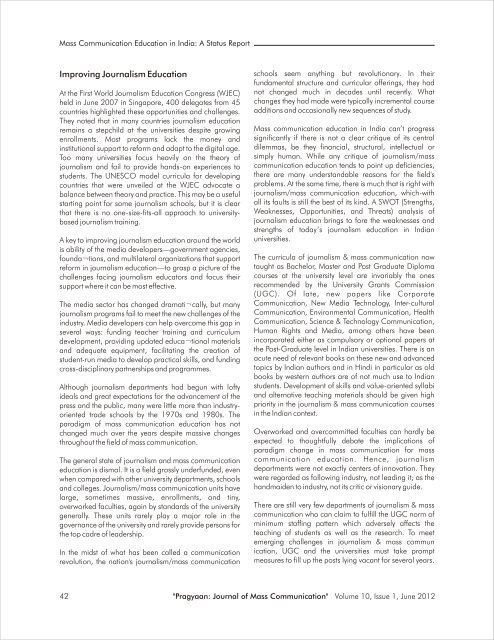Research Papers/Articles - Institute of Management Studies Dehradun
Research Papers/Articles - Institute of Management Studies Dehradun
Research Papers/Articles - Institute of Management Studies Dehradun
You also want an ePaper? Increase the reach of your titles
YUMPU automatically turns print PDFs into web optimized ePapers that Google loves.
Mass Communication Education in India: A Status Report<br />
Improving Journalism Education<br />
At the First World Journalism Education Congress (WJEC)<br />
held in June 2007 in Singapore, 400 delegates from 45<br />
countries highlighted these opportunities and challenges.<br />
They noted that in many countries journalism education<br />
remains a stepchild at the universities despite growing<br />
enrollments. Most programs lack the money and<br />
institutional support to reform and adapt to the digital age.<br />
Too many universities focus heavily on the theory <strong>of</strong><br />
journalism and fail to provide hands-on experiences to<br />
students. The UNESCO model curricula for developing<br />
countries that were unveiled at the WJEC advocate a<br />
balance between theory and practice. This may be a useful<br />
starting point for some journalism schools, but it is clear<br />
that there is no one-size-fits-all approach to universitybased<br />
journalism training.<br />
A key to improving journalism education around the world<br />
is ability <strong>of</strong> the media developers—government agencies,<br />
founda¬tions, and multilateral organizations that support<br />
reform in journalism education—to grasp a picture <strong>of</strong> the<br />
challenges facing journalism educators and focus their<br />
support where it can be most effective.<br />
The media sector has changed dramati¬cally, but many<br />
journalism programs fail to meet the new challenges <strong>of</strong> the<br />
industry. Media developers can help overcome this gap in<br />
several ways: funding teacher training and curriculum<br />
development, providing updated educa¬tional materials<br />
and adequate equipment, facilitating the creation <strong>of</strong><br />
student-run media to develop practical skills, and funding<br />
cross-disciplinary partnerships and programmes.<br />
Although journalism departments had begun with l<strong>of</strong>ty<br />
ideals and great expectations for the advancement <strong>of</strong> the<br />
press and the public, many were little more than industryoriented<br />
trade schools by the 1970s and 1980s. The<br />
paradigm <strong>of</strong> mass communication education has not<br />
changed much over the years despite massive changes<br />
throughout the field <strong>of</strong> mass communication.<br />
The general state <strong>of</strong> journalism and mass communication<br />
education is dismal. It is a field grossly underfunded, even<br />
when compared with other university departments, schools<br />
and colleges. Journalism/mass communication units have<br />
large, sometimes massive, enrollments, and tiny,<br />
overworked faculties, again by standards <strong>of</strong> the university<br />
generally. These units rarely play a major role in the<br />
governance <strong>of</strong> the university and rarely provide persons for<br />
the top cadre <strong>of</strong> leadership.<br />
In the midst <strong>of</strong> what has been called a communication<br />
revolution, the nation's journalism/mass communication<br />
42<br />
schools seem anything but revolutionary. In their<br />
fundamental structure and curricular <strong>of</strong>ferings, they had<br />
not changed much in decades until recently. What<br />
changes they had made were typically incremental course<br />
additions and occasionally new sequences <strong>of</strong> study.<br />
Mass communication education in India can’t progress<br />
significantly if there is not a clear critique <strong>of</strong> its central<br />
dilemmas, be they financial, structural, intellectual or<br />
simply human. While any critique <strong>of</strong> journalism/mass<br />
communication education tends to point up deficiencies,<br />
there are many understandable reasons for the field's<br />
problems. At the same time, there is much that is right with<br />
journalism/mass communication education, which-with<br />
all its faults is still the best <strong>of</strong> its kind. A SWOT (Strengths,<br />
Weaknesses, Opportunities, and Threats) analysis <strong>of</strong><br />
journalism education brings to fore the weaknesses and<br />
strengths <strong>of</strong> today’s journalism education in Indian<br />
universities.<br />
The curricula <strong>of</strong> journalism & mass communication now<br />
taught as Bachelor, Master and Post Graduate Diploma<br />
courses at the university level are invariably the ones<br />
recommended by the University Grants Commission<br />
(UGC). Of late, new papers like Corporate<br />
Communication, New Media Technology, Inter-cultural<br />
Communication, Environmental Communication, Health<br />
Communication, Science & Technology Communication,<br />
Human Rights and Media, among others have been<br />
incorporated either as compulsory or optional papers at<br />
the Post-Graduate level in Indian universities. There is an<br />
acute need <strong>of</strong> relevant books on these new and advanced<br />
topics by Indian authors and in Hindi in particular as old<br />
books by western authors are <strong>of</strong> not much use to Indian<br />
students. Development <strong>of</strong> skills and value-oriented syllabi<br />
and alternative teaching materials should be given high<br />
priority in the journalism & mass communication courses<br />
in the Indian context.<br />
Overworked and overcommitted faculties can hardly be<br />
expected to thoughtfully debate the implications <strong>of</strong><br />
paradigm change in mass communication for mass<br />
communication education. Hence, journalism<br />
departments were not exactly centers <strong>of</strong> innovation. They<br />
were regarded as following industry, not leading it; as the<br />
handmaiden to industry, not its critic or visionary guide.<br />
There are still very few departments <strong>of</strong> journalism & mass<br />
communication who can claim to fulfill the UGC norm <strong>of</strong><br />
minimum staffing pattern which adversely affects the<br />
teaching <strong>of</strong> students as well as the research. To meet<br />
emerging challenges in journalism & mass commun<br />
ication, UGC and the universities must take prompt<br />
measures to fill up the posts lying vacant for several years.<br />
"Pragyaan: Journal <strong>of</strong> Mass Communication" Volume 10, Issue 1, June 2012


